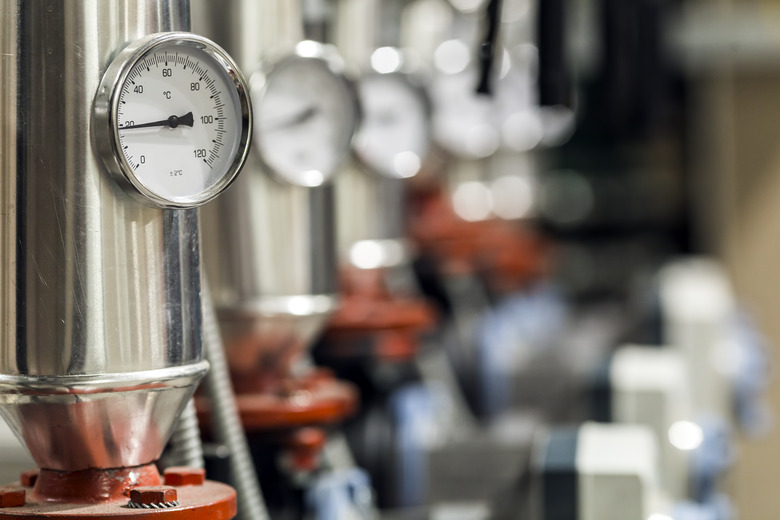What Is The Ideal Gas Law?
The Ideal Gas law is a mathematical equation you can use to solve problems relating to the temperature, volume and pressure of gases. Although the equation is an approximation, it's a very good one, and it's useful for a wide range of conditions. It uses two closely related forms that account for the quantity of a gas in different ways.
TL;DR (Too Long; Didn't Read)
The Ideal Gas law is PV = nRT, where P = pressure, V = volume, n = number of moles of gas, T is temperature and R is a proportionality constant, usually 8.314. The equation lets you solve practical problems with gases.
Real vs. Ideal Gas
Real vs. Ideal Gas
You deal with gases in everyday life, such as the air you breathe, the helium in a party balloon or methane, the "natural gas" you use to cook food. These substances have very similar properties in common, including they way they respond to pressure and heat. However, at very low temperatures, most real gases turn to liquid. An ideal gas, by comparison, is more of a useful abstract idea than a real substance; for example, an ideal gas never turns to liquid, and there's no limit to its compressibility. However, most real gases are close enough to an ideal gas that you can use the Ideal Gas law to solve many practical problems.
Volume, Temperature, Pressure and Amount
Volume, Temperature, Pressure and Amount
The Ideal Gas law equations have pressure and volume on one side of the equals sign and amount and temperature on the other. This means, the product of the pressure and the volume stays proportional to the product of the amount and temperature. If, for example, you increase the temperature of a fixed amount of gas in a fixed volume, the pressure must also increase. Or, if you keep the pressure constant, the gas must expand into a greater volume.
Ideal Gas and Absolute Temperature
Ideal Gas and Absolute Temperature
To use the Ideal Gas law correctly, you must employ absolute units of temperature. Degrees Celsius and Fahrenheit won't work because they can go to negative numbers. Negative temperatures in the Ideal Gas law give you negative pressure or volume, which can't exist. Instead, use the Kelvin scale, which starts at absolute zero. If you work with English units and want a Fahrenheit-related scale, use the Rankine scale, which also starts at absolute zero.
Equation Form I
Equation Form I
The first common form of the Ideal Gas equation is, PV = nRT, where P is pressure, V is volume, n is the number of moles of gas, R is a proportionality constant, typically 8.314, and T is temperature. For the metric system, use pascals for pressure, cubic meters for volume and Kelvins for temperature. To take one example, 1 mole of helium gas at 300 Kelvins (room temperature) is under 101 kilopascals of pressure (sea level pressure). How much volume does it occupy? Take PV = nRT, and divide both sides by P, leaving V by itself on the left side. The equation becomes V = nRT ÷ P. One mole (n) times 8.314 (R) times 300 Kelvins (T) divided by 101,000 pascals (P) give 0.0247 cubic meters of volume, or 24.7 liters.
Equation Form II
Equation Form II
In science classes, another common Ideal Gas equation form you'll see is PV = NkT. The big "N" is number of particles (molecules or atoms), and k is a Boltzmann's constant, a number that lets you use the number of particles instead of moles. Note that for helium and other noble gases, you use atoms; for all other gases, use molecules. Use this equation in much the same manner as the previous one. For example, a 1-liter tank holds 1023 molecules of nitrogen. If you lower the temperature to a bone-chilling 200 Kelvins, what is the pressure of the gas in the tank? Take PV = NkT and divide both sides by V, leaving P by itself. The equation becomes P = NkT ÷ V. Multiply 1023 molecules (N) by Boltzmann's constant (1.38 x 10-23), multiply by 200 Kelvins (T) and then divide by 0.001 cubic meters (1 liter) to get the pressure: 276 kilopascals.
Cite This Article
MLA
Papiewski, John. "What Is The Ideal Gas Law?" sciencing.com, https://www.sciencing.com/what-is-the-ideal-gas-law-13710230/. 14 March 2018.
APA
Papiewski, John. (2018, March 14). What Is The Ideal Gas Law?. sciencing.com. Retrieved from https://www.sciencing.com/what-is-the-ideal-gas-law-13710230/
Chicago
Papiewski, John. What Is The Ideal Gas Law? last modified August 30, 2022. https://www.sciencing.com/what-is-the-ideal-gas-law-13710230/
